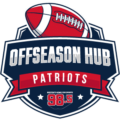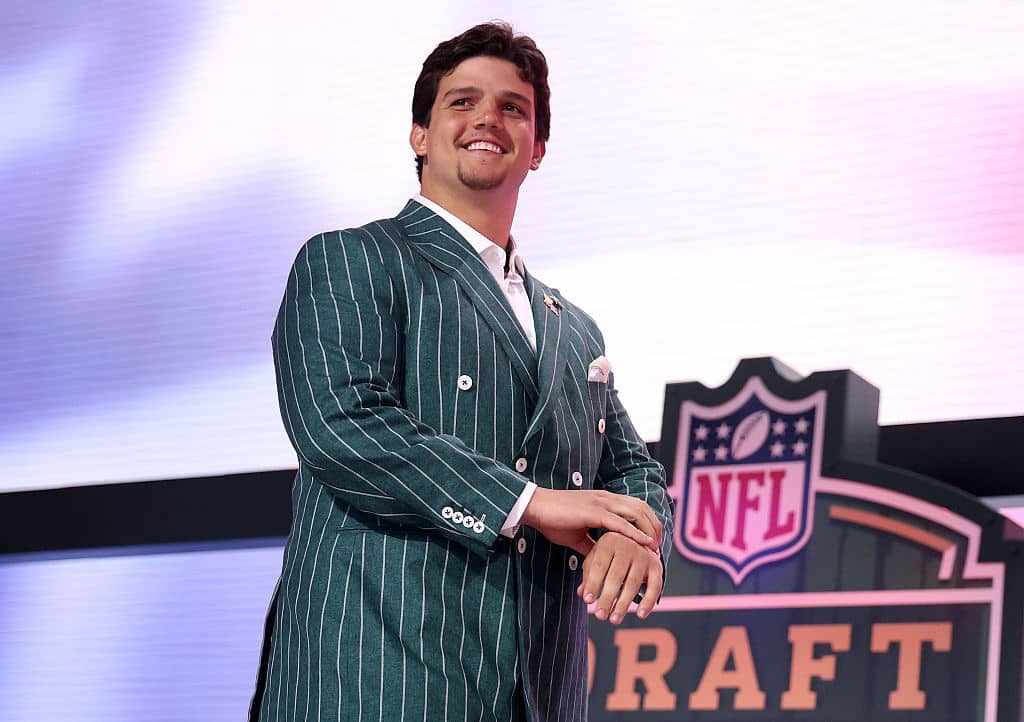As the pre-draft process goes on, it can be easy to lose sight of the bigger picture. While draft picks – first-round picks in particular – are expected to be cornerstone players for a franchise it’s important to remember they are one piece being plugged into a bigger puzzle.
With their first round pick in the 2025 NFL Draft, the New England Patriots took a player that projects as a much-needed piece for their puzzle. In drafting LSU tackle Will Campbell fourth overall, the Patriots aren’t just filling a need but adding a player who should help maximize their big investment from last year in quarterback Drake Maye.
For all of the Patriots’ struggles last year, the offensive line was arguably their biggest issue positionally. As a team the Patriots allowed a 40.7% pressure rate, which was the highest in the NFL according to Next Gen Stats. Maye in particular was pressured on 38.3% of his dropbacks, which was tied for the fourth most among individual quarterbacks with at least 300 pass attempts.
In free agency, the Patriots went to work on improving the offensive line. Their first move was signing veteran right tackle Morgan Moses. Not only does that upgrade that spot, but also ensures Mike Onwenu can stick at right guard where he’s at his best, rather than having to flip positions as needed like he has the last few years.

At center, the Patriots moved on from David Andrews, who suffered a season-ending shoulder injury in Week 4. In his place they signed 29-year-old Garrett Bradbury, who spent the last six years as the starting center for the Minnesota Vikings.
Those moves have the Patriots seemingly set and improved from the center all the way out to the right side. The left side? That remained a question.
For left guard, the Patriots don’t have a definitive answer but do have multiple players who can reasonably compete for the starting job. That group includes Sidy Sow, Layden Robinson, and Cole Strange. They could also add another left guard in this draft, but that was never realistic in the first round. Either way, they have options.
That’s more than can be said for the left tackle position. Entering Thursday night the team had just one true left tackle on the roster in last year’s starter, Vederian Lowe.
Lowe stepped in as the starter last year after Chuks Okorafor – who came out of camp with the job after spending his career as a right tackle in Pittsburgh – was benched in Week 1 and left the team in Week 2. Of 23 qualifying left tackles last year, Lowe ranked 18th in PFF’s pass blocking efficiency allowing 33 pressures and five sacks in 501 pass-blocking snaps. Lowe also committed 13 penalties, the fifth-most among left tackles and seventh-most among all tackles in the NFL in 2024.

After failing to make any additions at the position in free agency, the Patriots made the move in the draft, selecting Campbell. Campbell bringsas much experience against high-level competition as you’ll find in this draft, as a three-year starter in the SEC. Campbell was named second-team All-SEC as a true freshman in 2022, then was first-team All-SEC the last two years on top of earning a Consensus All-American nod last year.
Despite his success at LSU, there were some questions during the pre-draft process about whether or not Campbell would be viewed as a tackle or guard by NFL evaluators. That’s mainly due to his arm length – Campbell’s arms measured in at 33 inches during the pre-draft process, which is right on the line typically used as the benchmark to decide if players have the reach to play on the outside in the pros.
Based on head coach Mike Vrabel’s comments after the pick, that wasn’t a concern in New England.
“He’s a left tackle. That’s what he’s played, that’s what he’s done,” Vrabel said when asked about the plan for Campbell with the Patriots. “He’ll come in here and he’ll compete to be the left tackle just like everybody else is going to compete for their spots.”
That didn’t seem to be as much of an issue for the Patriots, with a report out of the NFL Combine indicating team decision makers “”see [Campbell] as a tackle — arm measurements be damned.”

When asked about arm length at the NFL Combine, Vrabel said it’s more about technique than just the measurement outright. “I think that arm length is good only up until the point to where you use it, right?,” he explained. “I think the most important thing is how you use whatever length you have. If you’re a long arm player that uses the length, then great, that’s an added plus. If you’re maybe an average length player that doesn’t use the length, that would be difficult. But if you’re using it, then that can be positive.”
Campbell, for his part, is up for whatever the Patriots ask him to do. “I’m just excited to get any opportunity that presents itself to help the team in any way that I can, wherever that might be, and I’m just excited to be a Patriot,” he said after being drafted. Asked about Maye in particular, Campbell told NFL Network “I’m going to fight and die to protect him with everything I’ve got.”
With Campbell in place, the Patriots have now made changes at three of their five offensive line spots, while locking a returning player into a fourth spot in Onwenu. In doing so they’ve added talent and ideally improved the continuity in front of Maye as he looks to make the Year 2 jump.
Not only should these moves help protect Maye in the pocket, but they should help the run game as well, allowing the offense to be more multi-dimensional which in turn will make things easier for Maye. Last year’s offensive line struggled against the run as well. Patriots running backs averaged just 1.02 yards before first contact last year, which was the seventh-lowest in the NFL.
The Patriots may not be done adding to their offensive line either. But whether they take another lineman or not (odds are probably better they will), they can say they made a significant investment in last year’s big investment, taking Campbell to make things easier for their second-year quarterback in Maye.

